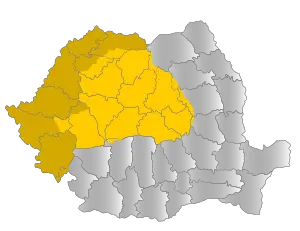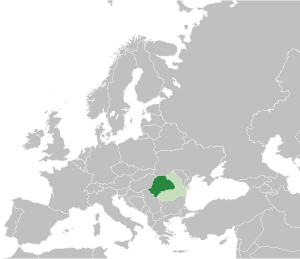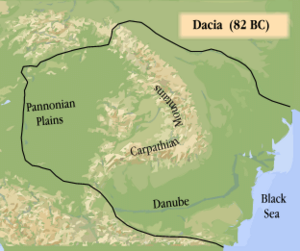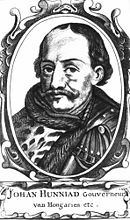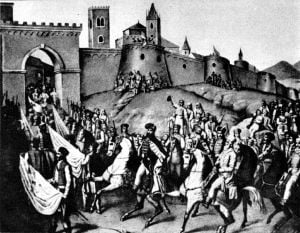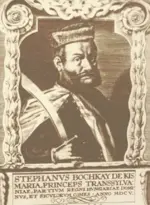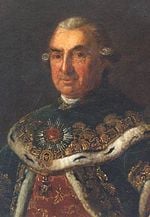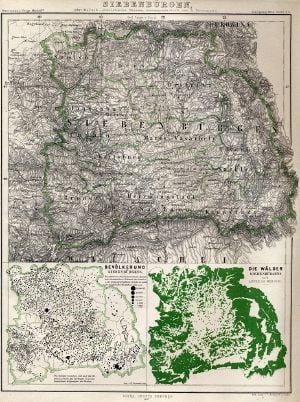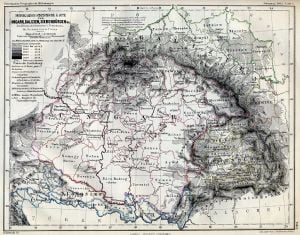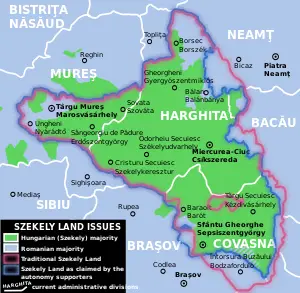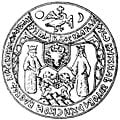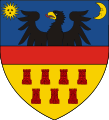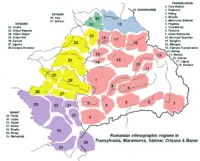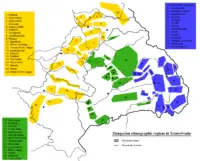Transylvania
Transylvania is a Central European region located in the eastern half of the Carpathian Basin, in present-day central Romania. Bounded in the east and south by the Carpathian mountain range, historic Transylvania extended in the west to the Apuseni Mountains. However, since 1919, Transylvania also encompasses, in the north-west, parts of the historical regions of Cri┼čana and Maramure┼č and in the west, eastern-Banat. With Moldavia and Wallachia it was one of three Romanian principalities which for six months at the turn of the seventeenth century were briefly united under Michael the Brave. Transylvania is an ancient land, once the nucleus of the powerful Kingdom of Dacia. After 106 C.E. the Roman Empire conquered the territory and its wealth (gold and salt) was systematically exploited. After the Romans' withdrawal in 271 C.E., it was subject to various temporary influences and migration waves: Visigoths, Carpians, Huns, and Gepids (Slavic peoples). Starting with the 10th century Magyar tribes slowly subdued Transylvania, which became part of the Kingdom of Hungary (eleventhÔÇôsixteenth century). After the Mohacs battle it was an autonomous principality within the Ottoman Empire (sixteenthÔÇôseventeenth century) and then once again became part of Hungary at the end of the seventeenth century. It was incorporated into Romania in 1920 along with Moldavia and Wallachia.
Outside Romania, Transylvania is strongly associated with Bram Stoker's novel Dracula while within Romania and Hungary the region is known for the scenic beauty of its Carpathian landscape and its rich history. Transylvania has been home to a variety of ethnic groups, which have traditionally lived together in harmony. In the sixteenth century, following the Protestant Reformation, it was characterized by religious tolerance that had no parallel at the time. Some of Transylvania's historical communities are, however, agitating for greater autonomy within Romania. Ethnic identity was suppressed during the communist period (1947-1989) submerged within a national identity. Where ethnic groups demand autonomy or self-governance, one solution is to allow the formation of smaller units which can then cooperate with others within a larger trans-national entity. Of course, few nations willingly agree to allow provinces or regions to secede. One solution is for the creation of more local governance across the globe within the contexts of larger structures such as the EU, which Romania joined in 2007, since it can be argued that as long as nation-states remain the main unit of political organization, justice and equality will elude the human race.
Etymology
Transylvania was first referred to in a Medieval Latin document in 1075 as ultra silvam, meaning "exceedingly forested" (ultra meaning "excessively or beyond what is common" and the accusative case of sylva (sylvam) meaning "wood or forest").
The modern English name is probably taken from the Hungarian Erd├ęly, which is derived from Erd┼Ĺ-elve meaning "beyond the forest" (a meaning first referred to in its Medieval Latin version in a twelfth century document - Gesta Hungarorum).[1] "Transylvania" means "beyond the forest" (trans meaning "across, over, beyond").
The German name Siebenb├╝rgen means "seven fortresses," after the seven (ethnic German) Transylvanian Saxons' cities in the region (Kronstadt, Sch├Ą├čburg, Mediasch, Hermannstadt, M├╝hlbach, Bistritz and Klausenburg). This is also the origin of many other languages' names for the region, such as the Polish Siedmiogr├│d.
The origin of the Romanian name Ardeal is controversial. The first known occurrence of the Romanian name appeared in a document in 1432 as Ardeliu.[2] It may be a result of an elision from the Romanian words aur and deal ("gold" and "hill," respectively), resulting in Ardeal from the composed word Aur-deal. It may also take its origin from the Khazar word ÔÇťArdil-landÔÇŁ (Hebrew "Eretz Ardil," from the Celtic "Arduenna" (forest), reflected in other names such as Arda, Ardal, Ardistan, Ardiche, Ardennes, Ardelt and Ardilla, or from the Sanskrit Har-Deal. Another hypothesis is that the name is borrowing of the Hungarian name Erd├ęly as is the Romanian name Ardyalo - in old Hungarian, Erd├ęly was pronounced as Erd├ęl. The initial e- in Hungarian occasionally changes to a in Romanian (cf. Hung. egres "gooseberry" and Egyed, which became agri┼č and Adjud in Romanian).
History
In its early history, the territory of Transylvania belonged to a variety of empires and states, including Dacia, the Roman Empire, the Hun Empire and the Gepid Kingdom.[3] There were also periods when autonomous political entities arose under the control of the Byzantine and the Bulgarian Empire.[4] As a political entity, (Southern) Transylvania is mentioned from the twelfth century as a county (Alba) of the Kingdom of Hungary (M. princeps ultrasilvanus - comes Bellegratae). Transylvania's seven counties were brought under the voivode's (count of Alba Iulia) rule in 1263.
It then became an autonomous principality under nominal Ottoman suzerainty in 1571. It was briefly united with Wallachia and Moldavi in 1600 under Michael the Brave. In 1688, it was added to the expanding territories of the Habsburgs, then became again a part of the Kingdom of Hungary within the newly established Austro-Hungarian Empire in 1867. Since World War I, it has been part of Romania, apart from a brief period of Hungarian occupation during World War II.
Cluj-Napoca is today considered to be the region's spiritual capital, although Transylvania was also ruled from Alba Iulia during its period as an autonomous principality within the Ottoman Empire, and from Sibiu, where the Habsburg governor was located from 1711 to 1848. The seat of the Transylvanian Diet was itself moved to Sibiu for some time in the nineteenth century.
Since medieval times, the population of the region has been a mixture of ethnic Romanians (historically known as Vlachs), Hungarians, the ethnic Hungarian Sz├ękely people, Germans (known as Transylvanian Saxons), Bulgarians, Armenians Jews and Roma (known as Gypsies or "tatars" - Tatern in Transylvanian Saxon or t─ât─âra┼či in Romanian.
The Roman province of Dacia, 105-271
The Kingdom of Dacia was in existence at least as early as the beginning of the 2nd century B.C.E. when, Rubobostes, a Dacian king from the territory of present-day Transylvania, undertook the control of the Carpathian basin by defeating the Celts who previously held the power in the region.
Dacia reached its maximum extent under the rule of Burebista. The area now constituting Transylvania was the political center of the ancient Kingdom of Dacia, where several important fortified cities were built; among them was the capital Sarmizegetusa, located near the current Romanian town of Hunedoara.
In 101-102 and 105-106 C.E., Roman armies under the Emperor Trajan fought a series of military campaigns to subjugate the wealthy Dacian Kingdom. The Romans under Trajan succeeded by 106 to subdue the south and the center regions of Dacia. After the conquest, the Romans seized an enormous amount of wealth (the Dacian Wars were commemorated on Trajan's Column in Rome) and immediately started to exploit the Dacian gold and salt mines located in today territory of Transylvania. Roman influence was broadened by the construction of modern roads, and some existing major cities, like Sarmizegethusa and Tsierna (today Orsova) were made colonies. The new province was divided under Hadrian: Dacia Superior, that corresponded roughly to Transylvania and Dacia Inferior, similar to the region of South Romania (Walachia). During Antoninus Pius (138-161) the same territory was included in the provinces Dacia Porolissensis (capital at Porolissum) and Dacia Apulensis (capital at Apulum, today Alba-Iulia city in Romania). The Romans built new mines, roads and forts in the province. Colonists from other Roman provinces were brought in to settle the land and found cities like Apulum (now Alba Iulia), Napoca (now Cluj-Napoca), Ulpia Traiana Sarmizegetusa and Aquae. During the Roman administration also Christianity entered in the current territory of Transylvania from the neighboring Roman provinces where, according to the tradition of the Romanian Orthodox Church, Saint Peter preached.
Due to increasing pressure from the Visigoths, the Romans abandoned the province during the reign of the Emperor Aurelian in 271. As across much of Europe, a period of chaos and conquests followed after the collapse of Roman rule. However, as shown by the archeological research, many of the Roman cities continued to exist, building fortifications. Also Christianity survived as proved by the many artifacts discovered. Among the most famous is the donarium from Biertan (fourth century) having the inscription 'Ego Zenovius votvm posui' (I, Zenovie, offered this). The territory fell under the control of the Visigoths and Carpians until they were in turn displaced and subdued by the Huns in 376, under the leadership of their infamous warlord Attila the Hun. After the disintegration of Attila's empire, the Huns were succeeded by Gepids of Eurasian Avar descent. The region was also influenced during this period by massive Slavic immigration.
At the beginning of the ninth century, Transylvania, along with eastern Pannonia, was under the control of the First Bulgarian Empire. After a brief period of Bulgarian rule, the territory, was partially under Byzantine control.
Conquest of Transylvania and integration into the Kingdom of Hungary
No written or architectural evidence bears witness to the presence of "proto-Romanians" the lands north of the Danube during the millennium after Rome's withdrawal from Dacia. This fact has fueled a centuries-long feud between Romanian and Hungarian historians over Transylvania.[5] The Romanians assert that they are the descendants of Latin-speaking Dacian peasants who remained in Transylvania after the Roman exodus, and of Slavs who lived in Transylvania's secluded valleys, forests, and mountains, and survived there during the tumult of the Dark Ages. Romanian historians explain the absence of hard evidence for their claims by pointing out that the region lacked organized administration until the twelfth century and by positing that the Mongols destroyed any existing records when they plundered the area in 1241. Hungarians assert, among other things, that the Roman population quit Dacia completely in 271, that the Romans could not have made a lasting impression on Transylvania's aboriginal population in only two centuries, and that Transylvania's Romanians descended from Balkan nomads who crossed northward over the Danube in the thirteenth century and flowed into Transylvania in any significant numbers only after Hungary opened its borders to foreigners.
Tenth-Twelfth centuries
Between tenth-twelfth centuries C.E. Transylvania was slowly conquered by the Magyar tribes, during a period of 300 years. At the beginning of the ninth century the Hungarian tribes were located in the north of the Black Sea. In 895 as a result of a planned 'conquest' and a massive withdrawal caused by a Hungarian conquest (War of 894-896) they established in the Upper-Tisza region and Transylvania and started to expand their territories towards west only in 899. According to the Gesta Hungarorum describing among others the conquest of Transylvania, three statal structures ruled by Menumorut, Glad and Gelu, the most powerful local leaders who opposed the Magyars were encountered and defeated by the Magyars. The privileged position of these figures tended to put brakes on the normal exercise of Romanian critical historiography[6].
Gelou (Gelu in Romanian, Gyalu in Hungarian) leader of the Vlachs (ancient Romanians )and Slavs in Transylvania was ruling over the Middle part of Transylvania and had his capital at D─âb├óca. He was defeated by the warriors of the Magyar chieftain T├ęt├ęny (also called T├Âh├Ât├Âm; in the original Latin: Tuhutum) sometime during the tenth century.
Duke Glad ruled over the South-West of Transylvania, having authority over the Slavs and Vlachs, which consisted most of the population of mentioned regions at the time. He was, according to the Gesta Hungarorum, a voivod (dux) from Bundyn (Vidin), ruler of the territory of Banat, during the ninth and tenth centuries. He also ruled part of south Transylvania, and Vidin region, and was a local governor or vassal of the First Bulgarian Empire under Bulgarian tsar Simeon. Glad was defeated by the Hungarians during the tenth century. One of his descendants, Ahtum, was a duke of Banat and the last ruler who opposed to the establishment of the Hungarian Kingdom in the eleventh century, but he was too, defeated by the Hungarian Crown.
Menumorut, a vassal of Byzantium ruled the lands between the River Tisza and the Ygfon Forest in the direction of Ultrasilvania (Transylvania), from the Mure┼č river to the Some┼č river. He declined the request of the Magyar ruler ├ürp├íd (907) to cede his territory between the Some┼č river and the Meses Mountains, and in the negotiations with the ambassadors Usubuu and Veluc of ├ürp├íd he invoked the sovereignty of the Byzantine Emperor Leo VI the Wise. The Magyars first besieged the citadel of Zotmar (Romanian: Satu Mare, Hungarian: Szatm├ír) and then Menumorut's castle in Bihar, and were able to defeat him. The Gesta Hungarorum then retells the story of Menumorut. In the second telling, he married his daughter into the ├ürp├íd dynasty. Her son Taksony, the grandson of Menumorut, became ruler of the Magyars and father of Mih├íly and G├ęza, whose son Vajk became the first King of Hungary in 1001 under the Christian baptismal name Stephen.
The early eleventh century was marked by the conflict between Stephen I of Hungary and his uncle Gyula, the ruler of Transylvania. The Hungarian ruler was successful in these wars, and Transylvania was incorporated into the Christian Kingdom of Hungary. The Transylvanian Christian bishopric and the comitatus system were organized.[7] By the early eleventh century the ethnic Hungarian]] Sz├ękely were established in southeastern Transylvania as a border population of ready warriors, and in the twelfth and thirteenth centuries, the areas in the south and northeast were settled by German colonists called Saxons. Romanians maintained control over a few autonomous regions called 'terrae': Fagaras, Amlas. Hateg, Maramures, Lapus. However the autonomy was taken by the end of ├ürp├íd dynasty in 1301.
Thirteenth-Fourteenth centuries
In 1241-1242, during the Mongol invasion of Europe, Transylvania was among the territories devastated by the Golden Horde. A large portion of the population perished. This was followed by a second Mongol invasion in 1285, led by Nogai Khan.
Following this devastation, Transylvania was reorganized according to a class system of Estates, which established privileged groups (universitates) with power and influence in economic and political life, as well as along ethnic lines. The first Estate was the lay and ecclesiastic aristocracy, ethnically heterogeneous, but undergoing a process of homogenization around its Hungarian nucleus. The other Estates were Saxons, Szeklers and Romanians (or Vlachs - Universitas Valachorum), all with an ethnic and ethno-linguistic basis (Universis nobilibus, Saxonibus, Syculis et Olachis). The general assembly (congregatio generalis) of the four Estates had few genuine legislative powers in Transylvania, but it sometimes took measures regarding order in the country.
After the Decree of Turda (1366), which openly called for "to expel or to exterminate in this country malefactors belonging to any nation, especially Romanians" in Transylvania, the only possibility for Romanians to retain or access nobility was through conversion to Roman Catholicism. Some Orthodox Romanian nobles converted, being integrated in the Hungarian nobility, but the most of them declined, thus losing their status and privileges.
In some border regions (Maramure┼č, ┼óara Ha┼úegului) the Orthodox Romanian ruling class of nobilis kenezius (classed as lower nobility in the Kingdom as a whole) had the same rights as the Hungarian nobilis conditionarius. Nevertheless, because of the gradual loss of a nobility of its own, Romanians were no longer able to keep their Universitas Valachorum.
Fifteenth century
A key figure to emerge in Transylvania in the first half of the fifteenth century was John Hunyadi (Iancu de Hunedoara), a native of Transylvania, born in a family of Romanian origins. According to the usage of Hungarian noblemen of the time, Iancu/John/J├ínos took his family name after his landed estate. He was one of the greatest military figures of the time, being Hungarian general (voivode) of Transylvania and then governor of the Kingdom of Hungary from 1446 to 1452. He was a Transylvanian noble of Romanian origin some sources indicating him as the son of Voicu/Vajk, a Romanian boyar (noble) from Wallachia though other sources are telling that his father was a Transylvanian Vlach/Romanian. Hungarian historians claim that his mother was Erzs├ębet Morzsinay the daughter of a Hungarian noble family. His fame was built in the effective wars of defense against the Turkish attacks, waged from 1439. With his private mercenary army John rapidly rose to the heights of power. His military campaigns against the Ottoman Empire]] brought him the status of Transylvanian governor in 1446 and papal recognition as the Prince of Transylvania in 1448. Continuing his military activity, he won an important victory at Belgrade in 1456, which halted the Ottomans advance for several decades, but died shortly afterwards during an epidemic.
After the suppression of the Budai Nagy Antal-revolt in 1437, the political system was based on Unio Trium Nationum (The Union of the Three Nations). According to the Union, which was explicitly directed against serfs and other peasants, society was ruled by three privileged Estates of the Nobility (mostly ethnic Hungarians), the Sz├ękelys, also an ethnic Hungarian people who primarily served as warriors, and the ethnic German, Saxon burghers.
The only possibility for Romanians to retain or access nobility in Hungarian Transylvania was through conversion to Catholicism. Some Orthodox Romanian nobles converted, becoming integrated into the Hungarian nobility. These circumstances marked the beginning of a conflict between ethnic Hungarian Catholics and ethnic Romanian Orthodox in the territory of Transylvania which in some regions remains unresolved to this very day.[8]
Transylvania as an Independent Principality
The sixteenth century in Southeastern Europe was marked by the struggle between the Muslim Ottoman Empire and the Catholic Habsburg Empire. After the Ottoman Sultan Suleiman the Magnificent overran central Hungary, Transylvania became a semi-independent principality where Austrian and Turkish influences vied for supremacy for nearly two centuries. It is this period of independence and Turkish influence that contributed to Transylvania being seen as exotic in the eyes of Victorians such as Bram Stoker, whose novel Dracula was published in 1897.[9]
Due to the fact that Transylvania was now beyond the reach of Catholic religious authority, Protestant preaching such as Lutheranism and Calvinism were able to flourish in the region. In 1568 the Edict of Turda proclaimed four religious expressions in Transylvania - Catholicism, Lutheranism, Calvinism and Unitarianism, while Orthodoxy, which was the confession of the Romanian population, was proclaimed as "tolerated" (tolerata).
The Báthory family began to rule Transylvania as princes under the Ottomans in 1571, and briefly under Habsburg suzerainty until 1600. The latter period of their rule saw a four-sided conflict in Transylvania involving the Transylvanian Báthorys, the emerging Austrian Empire, the Ottoman Empire, and the Romanian voivoideship (province) of Wallachia. This included a brief period of Romanian rule after the conquest of the territory by Wallachian voivod Michael the Brave. As he subsequently extended his rule over Moldavia, Michael the Brave unified for the first time in history all the territories where Romanians lived, rebuilding the mainland of the ancient Kingdom of Dacia.
The Calvinist magnate of Bihar county Stephen Bocskai managed to obtain, through the Peace of Vienna (June 23, 1606), religious liberty and political autonomy for the region, the restoration of all confiscated estates, the repeal of all "unrighteous" judgments, as well as his own recognition as independent sovereign prince of an enlarged Transylvania. Under Bocskai's successors, most notably Gabriel Bethlen and George I Rákóczi, Transylvania passed through a golden age for many religious movements and for the arts and culture. Transylvania became one of the few European States where Roman Catholics, Calvinists, Lutheranss and Unitarians lived in peace, although Orthodox Romanians continued to be denied equal recognition. The Unitarian Church of Transylvania, founded in 1568, is considered to be one of the oldest of the modern Unitarian movement.
This golden age and relative independence of Transylvania ended with the reign of George II Rákóczi. The prince, coveting the Polish crown, allied with Sweden and invaded Poland in spite of the Turkish Porte (Sultan) clearly prohibiting any military action. Rákóczi's defeat in Poland, combined with the subsequent invasions of Transylvania by the Turks and their Crimean Tatar allies, the ensuing loss of territory (most importantly, the loss of the most important Transylvanian stronghold, Oradea) and diminishing manpower led to the complete subordination of Transylvania, which now became a powerless vassal of the Ottoman Empire.
Within the Habsburg Empire
After the defeat of the Ottomans at the Battle of Vienna in 1683, the Habsburgs gradually began to impose their rule on the formerly autonomous Transylvania. Apart from strengthening the central government and administration, the Habsburgs also promoted the Roman Catholic Church, both as a uniting force and also as an instrument to reduce the influence of the Protestant nobility. In addition, they tried to persuade Romanian Orthodox clergymen to join the Greek (Byzantine Rite) in union with Rome. As a response to this policy, several peaceful movements of the Romanian Orthodox population advocated for freedom of worship for all the Transylvanian population, most notably being the movements led by Visarion Sarai, Nicolae Oprea Micl─âu┼č and Sofronie of Cioara.
From 1711 onward, the princes of Transylvania were replaced with Austrian governors and in 1765 Transylvania was declared a grand principality. However, within the empire, Transylvania "had a special legal status in which the nobility (including ethnic Hungarians and ethnic Romanians) were allowed to construct the legal systems and the local government structures".[10] Serfdom was abolished and "class differences were moderated ÔÇŽ by cooperative community social relations and practices, them-selves crafted from institutions inherited from the feudal past".[11]
The revolutionary year 1848 was marked by a great struggle between the Hungarians, the Romanians and the Habsburg Empire. Warfare erupted in November with both Romanian and Saxon troops, under Austrian command, battling the Hungarians led by the Polish born general J├│zef Bem. He carried out a sweeping offensive through Transylvania, and Avram Iancu]] managed to retreat to the harsh terrain of the Apuseni Mountains, mounting a guerrilla campaign on Bem's forces. After the intervention by the armies of Tsar Nicholas I of Russia, Bem's army was defeated decisively at the Battle of Timi┼čoara (Temesv├ír, Hun.) on August 9, 1849.
Having quashed the revolution, Austria imposed a repressive regime on Hungary, ruled Transylvania directly through a military governor and granted citizenship to the Romanians.
The 300-year long special separate status came to an end by the Austro-Hungarian Compromise of 1867, which established the dual monarchy and reincorporated Transylvania into the Kingdom of Hungary. On June 20, 1867, the Diet was dissolved by royal decree, and an ordinance abrogated the legislative acts of the Cluj-Napoca provincial assembly. The department of the interior inherited the responsibilities of the Transylvanian Gubernium, and the government reserved the right to name Transylvania's royal magistrates as well the Saxon bailiff of the Universitas Saxorum. Hungarian legislation also came to supersede the Austrian code of civil procedure, penal law, commercial law, and regulations for bills of exchange. The new unity of Austria-Hungary created a process of Magyarization affecting Transylvania's Romanians and German Saxons.
Part of Romania
Since the Austro-Hungarian empire had begun to disintegrate after the end of World War I, the nationalities living inside proclaimed their independence from the empire. The 1228-member National Assembly of Romanians of Transylvania and Hungary, headed by leaders of Transylvania's Romanian National Party and Social Democratic Party, passed a resolution calling for unification of all Romanians in a single state on 1 December in Alba Iulia. This was approved by the National Council of the Germans from Transylvania and the Council of the Danube Swabians from the Banat, on 15 December in Media┼č. In response, the Hungarian General Assembly of Cluj reaffirmed the loyalty of Hungarians from Transylvania to Hungary on December 22, 1918.
The Treaty of Versailles placed Transylvania under the sovereignty of Romania, an ally of the Triple Entente, and after the defeat in 1919 of B├ęla Kun's Hungarian Soviet Republic by the Romanian army the Treaty of St. Germain (1919) and the Treaty of Trianon (signed in June 1920) further elaborated the status of Transylvania and defined the new border between the states of Hungary and Romania. King Ferdinand I of Romania and Queen Maria of Romania were crowned at Alba Iulia in 1922 as King and Queen of all Romania.
In August 1940, the second Vienna Award granted the northern half of Transylvania to Hungary. After the Treaty of Paris (1947), at the end of World War II, the territory was returned to Romania. The post-WWII borders with Hungary, agreed on at the Treaty of Paris, were identical with those set out in 1920.
After World War II and especially after the fall of Communism, Transylvania lost almost all of the German-speaking population, most of them left for Germany.
After the Romanian Revolution of 1989, a Hungarian minority group is pressing for greater autonomy in the Szekler Region (the counties of Harghita and Covasna and part of Mures County) where its members outnumber Romanians[12] There have been tensions in Transylvania between Romanians and ethnic Hungarians who want autonomy. The Hungarians said they were the target of attacks by Romanian politicians and news organizations. They say the aim is to forcibly assimilate the Hungarian minority of 1.7 million people, or 7.1 percent of the Romanian population. Romanians chided the Hungarians for refusing to integrate and in some cases for their ignorance of the Romanian language.
The Szekler National Council is a local Hungarian group founded in 2003 with autonomy as its stated goal. It has been emboldened by Kosovo's 2008 declaration of independence from Serbia, although unlike the Kosovars, the Szeklers are asking for autonomy within Romania rather than complete independence, leaving foreign policy and national defense in the hands of the government in Bucharest. There are those who argue that the European Union, of which Romania is a member, provides a framework for the devolution of greater autonomy to regions, just as some powers can be devolved to the Union. Some regional parties in the European space view the Union as an ally in their bid for autonomy, which already provides economic support directly to regions as well as hearing human rights cases and even security. Thus, one writer suggests:
the following causal mechanism: European integration has created conditions under which regional groups (e.g. the Scottish) may not need the state (e.g. United Kingdom) to survive internationally. In particular, the European Union decreases regional dependency on the nation-state in both economic (i.e. international trade and monetary policy) and political terms (e.g. defense, foreign policy, and minority rights).[13]
A new and more radical organization, the Hungarian Civic Party, has risen to challenge the establishment Hungarian party and has advocated for the autonomy of the Szekler region.[14] The Hungarian politician, L├íszl├│ T┼Ĺk├ęs, one of the party leaders, is pressing for greater autonomy, saying that Romanian and Hungarian authorities have to reach an agreement regarding the statute of the Hungarian community, the Szeckler county respectively. [15]. Romania residents of the Hungarian dominated area claim that their interests are ignored by the local government, which, for example, distributes aid to church-run schools unevenly, while use of Hungarian by many institutions and clubs excludes them by default (many are not bilingual, partly because Hungarians do not encourage Romanians to learn Hungarian but complain when they Romanians can't speak the language. Others regard the history of inter-cultural tolerance in Transylvania as too strong for a Kosovo-type conflict to occur. Lovatt says that regardless of a persons ethnic origin, a distinctive "'Transylvanian identity' is developing. "This," she says, "may help to explain why there was no escalation of violent ethnic conflict in Transylvania." "All nationalities living in Transylvania - Romanians, Hungarians and Germans - have more in common," she says, "than distinctive features" in how they construct their identity. "In other words," she continues, referring to the writing of Mungiu-Pippidi. "they form an in-group with other Transylvanians, regardless of their ethnic origin."[16] In fact, in sharp contrast to how many in Europe traditionally regarded Transylvania, as a place of "despots, vampires and werewolves," Transylvanians regard their homeland as "an enlightened place of religious tolerance, reform and learning."[17]
Historical coat of arms of Transylvania
The first heraldic representation of Transylvania is found on the coat of arms of Michael the Brave. Besides the Walachian eagle and the Moldavian auroch, Transylvania is here represented by two afronted lions holding a sword (elements referring to the Dacian Kingdom), standing upon seven hills.
The Transylvanian Diet of 1659 codified the representation of the privileged nations in Transylvania's coat of arms. It depicts:
- A black turul on a blue background, representing the medieval nobility, which was mainly Magyar.
- The Sun and the Moon representing the Sz├ękelys.
- Seven red towers on a yellow background representing the seven fortified cities of the Transylvanian Saxons
(The red dividing band was originally not part of the coat of arms.)
Geography and ethnography
The Transylvanian plateau, 300 to 500 meters (1,000-1,600 feet) high, is drained by the Mure┼č, Some┼č, Cri┼č, and Olt rivers, as well as other tributaries of the Danube. This core of historical Transylvania roughly corresponds with nine counties of modern Romania. Other areas to the west and north, which also united with Romania in 1918 (inside the border established by peace treaties in 1919-20), are since that time widely considered part of Transylvania.
- Transylvania proper:
- Amla┼č
- Ţara Bârsei
- Chioar
- Ciceu
- F─âg─âra┼č
- Haţeg
- M─ârginimea Sibiului
- Câmpia Transilvaniei
- Ţara Moţilor
- Ţara Năsăudului
- Ţinutul Pădurenilor
- Banat
- Cri┼čana
- Ţara Zarandului
- Maramure┼č
- ┼óara LăÄpu┼čului
- Oa┼č Country
In common reference, the Western border of Transylvania has come to be identified with the present Romanian-Hungarian border, settled in the Treaty of Trianon, although geographically the two are not identical.
Administrative divisions
The historical region granted to Romania in 1920 covered 23 counties including nearly 102,200 km² (102,787 - 103,093 in Hungarian sources and 102,200 in contemporary Romanian documents) now due to the several administrative reorganizations Transylvania covers 16 present-day counties Romanian: judeţ) which include nearly 99,837 km² of central and northwest Romania. The 16 counties are:
- Alba County
- Arad County
- Bihor County
- Bistriţa-Năsăud
- Bra┼čov County
- Cara┼č-Severin
- Cluj
- Covasna
- Harghita
- Hunedoara
- Maramure┼č
- Mure┼č County
- S─âlaj County
- Satu Mare
- Sibiu
- Timi┼č
The most populous cities are:
- Cluj-Napoca (318,027)
- Timi┼čoara (317,651)
- Bra┼čov (283,901)
- Oradea (206,527)
- Arad (172,824)
- Sibiu (155,045)
- T├órgu Mure┼č (149,577)
- Baia Mare (137,976)
- Satu Mare (115,630).
Population
Historic definitions of Transylvania vary geographically. The 2002 Romanian census classified Transylvania as the entire region of Romania west of the Carpathians. This region has a population of 7,221,733, with a large Romanian majority (75,9 percent). There are also sizeable Hungarian (20 percent), Roma (3.3 percent), German (0.7 percent) and Serb (0.1 percent) communities.[18] The ethnic Hungarian population of Transylvania, largely composed of Sz├ękely, form a majority in the counties of Covasna and Harghita.
The percentage of Romanian majority has increased since the union of Transylvania with Romania after World War I in 1918 (the 1910 Census indicates a total population of 5,262,495, Romanians 53.8 percent; Hungarians 31.6 percent; Germans 10.7 percent). This is due to the emigration of non-Romanian peoples, assimilation and internal migration within Romania (estimates show that between 1945 and 1977, some 630,000 people moved from the Old Kingdom to Transylvania, and 280,000 from Transylvania to the Old Kingdom, most notably to Bucharest).[19] The assimilation process for Hungarians slowed during the first stages of the communist era, when most of the region's ethnic Hungarian population was granted nominal political autonomy, but accelerated under the communist regime.
Economy
Transylvania is rich in mineral resources, notably lignite, iron, lead, manganese, gold, copper, natural gas, salt and sulfur.
There are large iron and steel, chemical, and textile industries. Stock raising, agriculture, wine production and fruit growing are important occupations. Timber is another valuable resource.
Transylvania accounts for around 35 percent of Romania's GDP, and has a GDP per capita (PPP) of around $11,500, around 10 percent higher than the Romanian average.
Tourist attractions
- The medieval cities of Alba Iulia, Cluj-Napoca, Sibiu (European Capital Of Culture-2007), T├órgu Mure┼č and Sighi┼čoara
- The city of Bra┼čov and the nearby Poiana Bra┼čov ski resort
- The city of Hunedoara with the fourteenth century Hunyadi Castle
- The citadel and the Art Nouveau city centre of Oradea
- The Wooden Churches of the Maramure┼č region
- The Dacian Fortresses of the Or─â┼čtie Mountains, including Sarmizegetusa
- The Saxon fortified churches
- Hungarian traditions and folk culture
- The cafe culture, street theatre and cosmopolitan society of Sibiu
Villages with fortified churches were declared World Heritage Sites in 1993[20]
Transylvania in fiction
Transylvania's long history of Muslim Turkish influence, as well as its late industrialization (which meant that in the late nineteenth century, Transylvania was still mostly covered with wilderness, created an orientalist fascination with the region by a number of notable Victorian writers. Following the publication of Emily Gerard's The Land Beyond the Forest (1888), Bram Stoker wrote his gothic horror novel Dracula in 1897, using Transylvania as a setting. Due to the success of the latter work, Transylvania became associated in the English-speaking world with vampires. Since then it has been represented in fiction and literature as a land of mystery and magic. For example, in Paulo Coelho's novel The Witch of Portobello, the main character, Sherine Khalil, is described as a Transylvanian orphan with a Romani mother, in an effort to add to the character's exotic mystique. The so-called Transylvanian trilogy of historical novels by Miklos Banffy, The Writing on the Wall, is an extended treatment of the nineteenth and early twentieth century social and political history of the country.
Another novel featuring Transylvania is The Sight, by author David Clement-Davies.
Notes
- ÔćĹ The "Gesta Hungarorum" and the Romanian continuity theory. Eliznik.org. Web Pages for Balkan Folklore. Retrieved September 13, 2008. An anonymous late twelfth century chronicle.
- ÔćĹ ┼×tefan Pascu, Voievodatul Transilvaniei, volume I. (Cluj, RO: Dacia, 1971), 22.
- ÔćĹ B├ęla K├Âpeczi (ed.), History of Transylvania: 3. The Kingdom of the Gepids. (Boulder, CO: Atlantic Research and Publications, Inc., 2001-2002). Retrieved September 13, 2008.
- ÔćĹ B├ęla K├Âpeczi (ed.), 6. Southern Transylvania under Bulgar rule. (Boulder, CO: Atlantic Research and Publications, Inc., 2001-2002). Retrieved September 13, 2008.
- ÔćĹ Transylvanian Ethnic Groups www.everyculture.com. Retrieved July 17, 2012.
- ÔćĹ Lucian Boia, History and myth in Romanian consciousness. (Budapest, HU: Central European University Press,2001, ISBN 9780585419466), 222.
- ÔćĹ An administrative system of county-type units.
- ÔćĹ Romania Confronts Transylvanian Separatism. STRATFOR's Global Intelligence Update June 9, 1999. Retrieved September 13, 2008.
- ÔćĹ Stoker may have modeled his Dracula on Vlad III the Impaler, who was ruler of Walachia, not Transylvania.
- ÔćĹ Roper and Fesnic, 2003, 121.
- ÔćĹ David A. Kideckel, The Solitude of Collectivism: Romanian Villagers to the Revolution and Beyond. (Ithaca, NY: Cornell University Press, 1993, ISBN 9780801427466), 127.
- ÔćĹ Stephan Orth, Nadine Michel, and Maike Jansen, Separatist Movement seeks inspiration in Kosovo. Spiegel International (2008). Retrieved September 13 2008.
- ÔćĹ Seth Kincaid Jolly, European Integration and the Rise of Regional Parties. (Durham, NC: Duke University, 2004). Retrieved September 13, 2008.
- ÔćĹ Nicholas Kulish, KosovoÔÇÖs Actions Hearten a Hungarian Enclave. New York Times (2008). Retrieved September 13, 2008.
- ÔćĹ Magyar Autonomy, An Issue Romania Needs To Deal With. Mediafax. Retrieved September 13, 2008.
- ÔćĹ Catherine Lovatt, Tolerant Transylvania: Why Transylvania will not become another Kosovo. Central Europe Review 1 (1999):14. citing Alina Mungiu-Pippidi, Subjective Transylvania: A Case Study of Post-communist nationalism. (Budapest: Open Society Institute, 1999), 36. Retrieved September 13, 2008.
- ÔćĹ Mungiu-Pippidi, 1999, 2.
- ÔćĹ Structura Etno-demografic─â a Rom├óniei. Ethnocultural Diversity Resource Centre. 2002. Retrieved September 13, 2008.
- ÔćĹ E. ├ürp├íd Varga, Hungarian population of Transylvania between 1870 and 1995. (Budapest, HU: Teleki L├íszl├│ Foundation, 1999, ISBN 9789630374590), 27.
- ÔćĹ Villages with Fortified Churches in Transylvania. UNESCO. Retrieved January 16, 2009.
ReferencesISBN links support NWE through referral fees
- This article incorporates text from the Encyclop├Ždia Britannica Eleventh Edition, a publication now in the public domain.
- Bánffy, Miklós, and Miklós Bánffy. The Writing on the Wall: The Transylvanian Trilogy. London, UK: Arcadia Books, 1999. ISBN 9781900850100.
- Boia, Lucian. History and myth in Romanian consciousness. Budapest, HU: Central European University Press, 2001. ISBN 9780585419466.
- Clement-Davies, David. The sight. New York, NY: Dutton Books, 2002. ISBN 9780525467236.
- Coelho, Paulo, and Margaret Jull Costa. The witch of Portobello: A novel. New York, NY: Harper Collins Publishers, 2007. ISBN 9780061338809.
- Du Nay, Alain, Andr├ę Du Nay, and ├ürp├íd Kosztin. Transylvania and the Rumanians. Hamilton, CA: Matthias Corvinus Pub, 1997. ISBN 9781882785094.
- Fermor, Patrick Leigh. Between the Woods and the Water. New York, NY: Viking, 1986. ISBN 9780670811496. Fermor traveled across Transylvania in the summer of 1934, and wrote about it in this account first published more than 50 years later, in 1986.
- Gerard, Emily. The Land Beyond the Forest. New York, NY: Harper, 1888. ISBN 9781112404948.
- Kideckel, David A. The Solitude of Collectivism: Romanian Villagers to the Revolution and Beyond. Ithaca, NY: Cornell University Press, 1993. ISBN 9780801427466.
- K├Âpeczi, B├ęla (ed.). History of Transylvania. Boulder, CO: Atlantic Research and Publications, Inc, 2001-2002.
- Lipcsey, Ildik├│, Sabin Gherman, and Adrian Severin. Romania and Transylvania in the 20th century. Buffalo, NY: Corvinus Pub, 2006. ISBN 9781882785155.
- Mungiu-Pippidi, Alina. Subjective Transylvania: A Case Study of Post-communist nationalism. Budapest, HU: Open Society Institute, 1999. Retrieved September 13, 2008.
- Pascu, ╚śtefan. Voievodatul Transilvaniei. Cluj, RO: Dacia, 1971.
- Pascu, ╚śtefan. A History of Transylvania. Detroit, MI: Wayne State University Press, 1982. ISBN 9780814317228.
- Riley, Bronwen, and Dan Dinescu. Transylvania. London, UK: Frances Lincoln, 2007. ISBN 9780711227811.
- Roper, Steven D. and Fesnic, Florin. "Historical Legacies and their Impact on Post-Communist Voting Behavior." Europe-Asia Studies 55(1) (2003):119-191.
- Stoker, Bram. Dracula. Richmond, VA: Oneoworld Classics, 2008. ISBN 9781847490261. (Fiction)
- Varga, E. Árpád. Hungarian population of Transylvania between 1870 and 1995. Budapest, HU: Teleki László Foundation, 1999. ISBN 9789630374590.
Gallery of Images
External links
All links retrieved May 1, 2023.
- RTI Radio - Radio Transsylvania International.
- The History Of Transylvania And The Transylvanian Saxons by Dr. Konrad G├╝ndisch, Oldenburg, Germany.
Credits
New World Encyclopedia writers and editors rewrote and completed the Wikipedia article in accordance with New World Encyclopedia standards. This article abides by terms of the Creative Commons CC-by-sa 3.0 License (CC-by-sa), which may be used and disseminated with proper attribution. Credit is due under the terms of this license that can reference both the New World Encyclopedia contributors and the selfless volunteer contributors of the Wikimedia Foundation. To cite this article click here for a list of acceptable citing formats.The history of earlier contributions by wikipedians is accessible to researchers here:
The history of this article since it was imported to New World Encyclopedia:
Note: Some restrictions may apply to use of individual images which are separately licensed.
